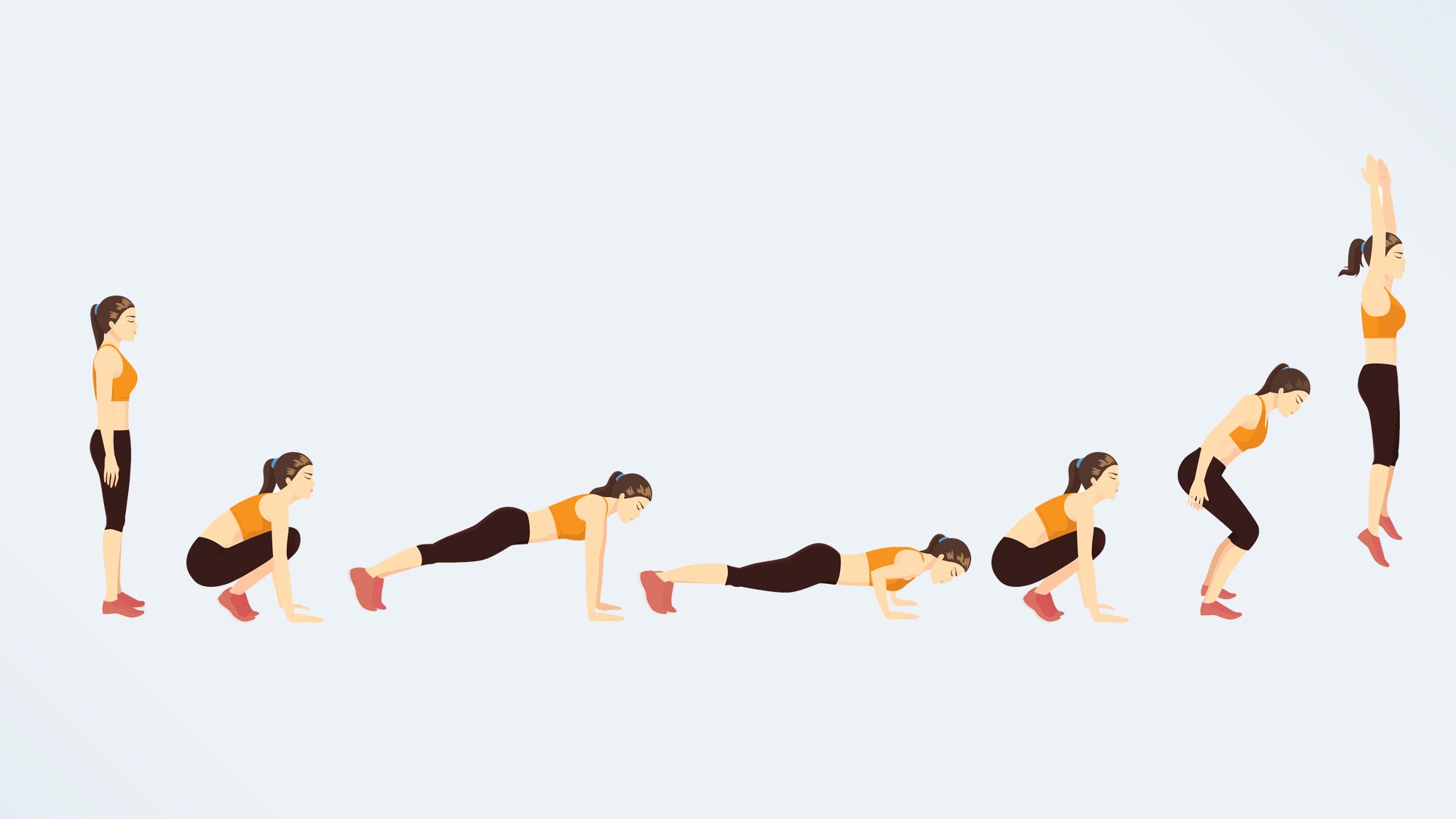
Burpees are one of the most well-known bodyweight exercises in fitness. And however you find yourself powering out the reps, the exercise could help build power, muscle, and strength and burn calories as part of a regular exercise regime.
But do you know how to do a burpee properly? It looks like a lot of jumping around, but the exercise is easy to get wrong. Fitness fanatics and beginners report lower back pain or tight hip flexor muscles, which could affect burpee form and lead to other injuries. I know, boring, right? But correct form should be learned from the ground up before you add any exercise into your arsenal.
Get it right, and you can safely hit every major muscle group in your body, including your chest, arms, shoulders, core, legs and back. Below, we cover how to do a burpee with good form and the benefits of burpees. If burpees are off the table completely, we also provide burpee variations to try. If you’re currently fitting out your home gym, find the best home gym equipment to boost workouts, and we recommend these wireless headphones to stay secure during sweaty burpee reps.
How to do a burpee

- Start standing with your feet hip-width or shoulder-width apart
- Place your hands on the ground, then jump both feet back into a high plank position
- Lower your chest to the floor into a bodyweight push-up
- Explosively push the ground away and straighten your arms, lifting your hips and chest as one unit. Try to avoid arching your lower back
- Jump your feet forward just behind your arms, then explode back to standing, raising your arms above your head and jumping into the air.
Benefits of burpees

Burpees are a compound exercise that work multiple muscle groups and joints and could help develop explosive power, cardio fitness, and full-body strength, especially in your chest, shoulders, and legs. The best part is, burpees are an incredibly tough bodyweight exercise without weights or equipment. That means you can do it anywhere and still work up a sweat and raise your heart rate.
Muscles worked during burpees include your legs (especially your quads), hip flexors, core muscles, chest, shoulders, triceps, and back muscles.
And research by the International Journal of Environmental Research and Public Health even found a link between performing burpees and improvements in short-term memory and endurance in adolescents when tested against an “all out” 2000m running test and Jacob’s memory test. So, apparently, they can even keep you sharp!
Common burpee mistakes
Here are some common burpee mistakes and how to fix them.
Get instant access to breaking news, the hottest reviews, great deals and helpful tips.
Burpee: hip dipping
At the bottom of a burpee, it’s common for people to drop their hips and press from their chest. Doing this places stress on the lower back and cause overextension. Instead, engage your core and lift your chest and hips as one solid unit, contracting as many muscles as you possibly can throughout.
Burpee: heel jump
I regularly catch people landing on their heels, putting excess strain on the knees and ankles. Aim to land on the balls of your feet and explosively jump upwards from this position. This way, you engage your calves and can explode upwards with more power.
Burpee: lack of control
During burpee challenges, AMRAPs, EMOMs, or workout finishers, throwing yourself to the ground to max your reps is tempting, but this could do more harm than good. As you jump back into a high plank position, squeeze your glutes and maintain a soft elbow bend, then lower your body to the ground with control before explosively pushing back up. That way, you keep your joints and lower back safe while working your muscles harder.
Two burpee variations to try
Are you bored of burpees? These two alternatives build full-body strength and power, and I recommend giving these two a try if burpees are a contraindication for you.
1. Sprawls

Recently, I did 80 sprawls every day for a week, and here’s what happened to my body. But if that doesn’t put you off, give sprawls a try. Here’s how:
- Start in a push-up position and brace your core, shoulders stacked over your wrists
- With explosive power, jump both feet to land outside of your hands with heels planted down
- Lower your bum and lift your chest, then lift both hands in front of you
- Place both hands back down on the floor, then jump both feet back into a push-up position.
Focus on squeezing your stomach muscles during the jump back and contract your chest, glutes, and quads to keep your body tight. Typically, you wouldn't add the jump here, but you can for an extra challenge.
2. Straight-arm burpee

Also known as a half burpee or down-up, straight-arm burpees are the best exercise for beginners and anyone who needs to protect their lower back. As a caveat, always check with a personal trainer or medical professional to clear you for exercise if you suffer from a lower back injury.
Perform a burpee as you usually would, but without the push-up. The variation is similar to a sprawl, except you’ll still jump both feet behind your hands and land on the balls of your feet, then jump into the air. You should be able to increase your tempo and achieve more reps this way, too.
For more workout inspiration, our editor did burpees every day for a week, and this 300-rep bodyweight workout is perfect for building explosive leg power using box jump burpees. The burpee reps in the UK’s Fittest Man 2020 workout nearly ended me.
For beginners, you can build your glutes without weights. Tight hip flexors? These stretches for hip flexor pain are game changers.

Sam Hopes is a level 3 qualified trainer, a level 2 Reiki practitioner and fitness editor at Tom's Guide. She is also currently undertaking her Yoga For Athletes training course.
Sam has written for various fitness brands and websites over the years and has experience across brands at Future, such as Live Science, Fit&Well, Coach, and T3.
Having coached at fitness studios like F45 and Virgin Active and personal trained, Sam now primarily teaches outdoor bootcamps, bodyweight, calisthenics and kettlebells.
She also coaches mobility and flexibility classes several times a week and believes that true strength comes from a holistic approach to training your body.
Sam has completed two mixed doubles Hyrox competitions in London and the Netherlands and finished her first doubles attempt in 1:11.
